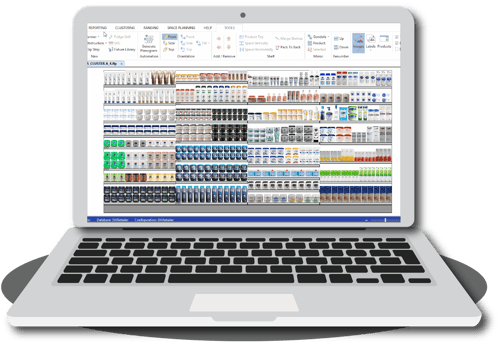
Category Management
Category management is the structured and collaborative process of managing product groups as strategic business units with the aim of improving category performance through efficient consumer response.
It includes but is not limited to pricing, promotion, placement (planograms and floor planning), assortment, and cluster planning.
TABLE OF CONTENTS
WHAT IS CATEGORY MANAGEMENT?
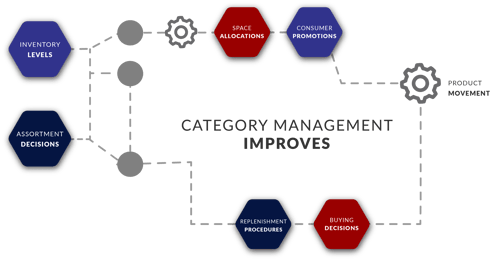
Category Management is the structured and collaborative process of managing product groups as strategic business units with the aim of improving improved category performance through efficient consumer response.
It includes but is not limited to pricing, promotion, placement (planograms and floor planning), assortment, and cluster planning.
Category Management also aims to provide customers with what they want, where they want it, and when they want it. To accomplish that, you can group products into categories according to how they are used, consumed or purchased.
WHAT IS THE ULTIMATE GOAL OF CATEGORY MANAGEMENT?
The goal of category management is to obtain long-term improvements in the efficiencies of the retailer, which leads to increased sales, an improved shopping environment, and customer loyalty.
The idea behind category management is also pretty straightforward: to manage each product category in a way that enables maximum consumer appeal while also increasing your profits.
As a category manager, you can learn how to develop the best possible customer proposition by implementing data-driven assortment planning, having competitive pricing, attractive promotions, and visually appealing planograms.
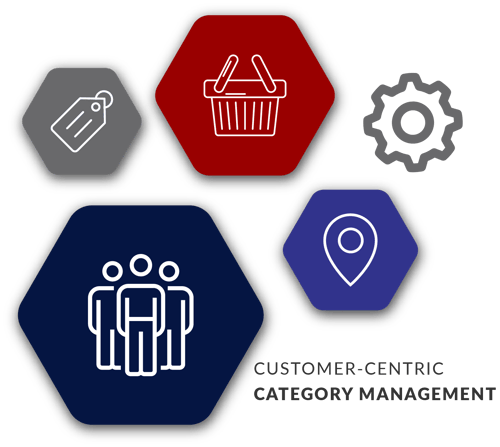
CUSTOMER-CENTRIC CATEGORY MANAGEMENT
- Which products will be purchased;
- How they will be grouped (categorised);
- Where they will be displayed; and
- How they will be displayed.
- The actual product (size, weight, use, quantity);
- Price;
- Marketing message; and
- Location.
WHERE DO YOU COME IN WITH CATEGORY MANAGEMENT?
As a shelf planner, you need to continually strive to understand the customer when making decisions regarding a shelf. That is because each aspect has an impact on the other.
For example, the size of your product will impact where you place it on the shelf.
Your marketing message may have an impact on the price. However, the consumer decision-making process is at the centre, so the spending power of your customer will impact which products you keep in store.
It will also influence where you keep these products.
UNPACKING THE SIX-STEP CATEGORY MANAGEMENT PROCESS
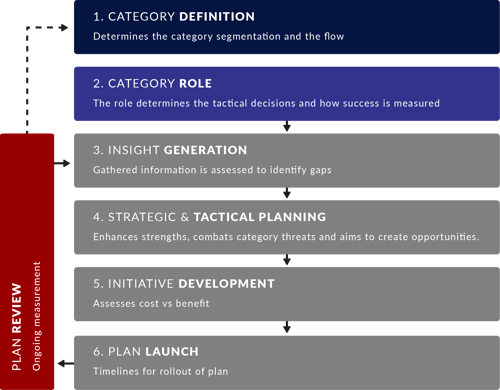
While there is debate over the number of steps involved - some say as many as eight while others peg it at five, at DotActiv, we follow a six-step process. It includes:
- Category Definition;
- Category Role;
- Insight Generation;
- Strategic and Tactical Planning;
- Initiative Development; and
- Plan Launch.
1. CATEGORY DEFINITION
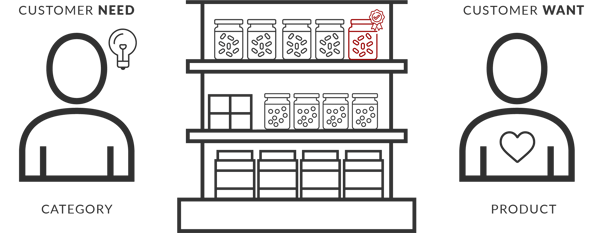
The purpose of the category definition step is to determine the specific SKUs that will make up your category. A good starting point here would be to put yourself in the shoes of your customers. Then, ask yourself how you would define it if you were them.
When defining your category, you are asking the following:
- What consumer need must I satisfy with this category?
Your category fulfils the need while the specific product fulfils the consumer want.
CATEGORY SEGMENTATION
There are various factors that you should take into consideration before creating the category hierarchy and consumer decision tree.

Above: A Consumer Decision Tree when purchasing a cold beverage.
That said, it is unlikely that there is only one consumer decision tree per category. There are many different consumer behaviours based on cultural, personal, physiological and social factors within a consumer base. And, for each of these segments, there is a different focus or priority.
For example, your shoppers may be price sensitive, which means the price will feature higher on their consumer decision tree.
On the other hand, they may be highly visual, which means packaging and brand becomes key in their decision-making.
Meanwhile, others could be looking for functionality and convenience. Thus packaging functionality, such as individually wrapped products or the ability to reseal a product may influence their decision.
Also, the segments that exist are likely to vary by category, so it is vital to understand your consumer and what they view as important.
On the right is an example to illustrate our point.
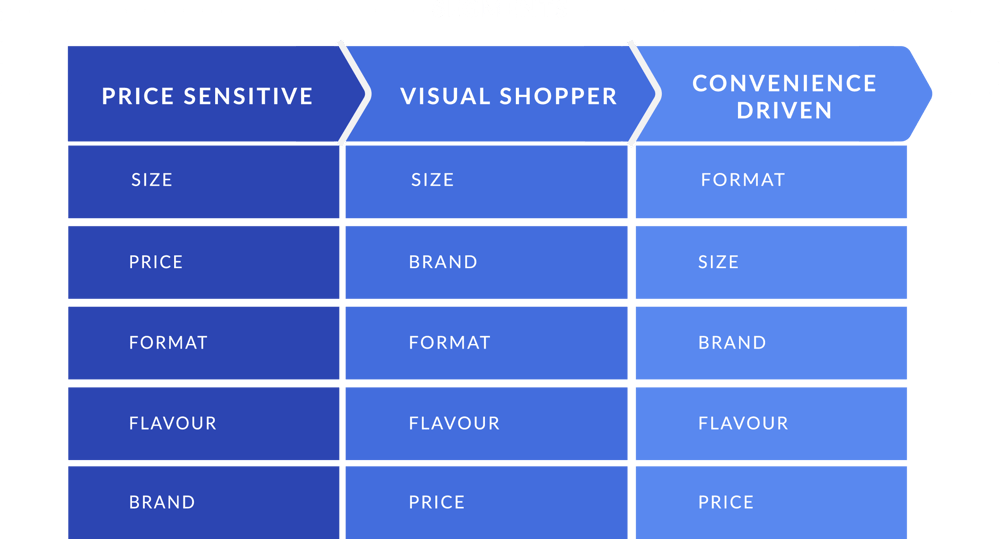
THE CONSUMER DECISION TREE AND CATEGORY HIERARCHY
A significant component in the category definition phase is developing a consumer decision tree.
A consumer decision tree (CDT) is a graphical record that assists retailers to understand consumer buying habits and the decision-making processes of individuals while they shop in a category.
The order of priority in which customers make their purchasing decisions details the various product attributes (such as price, flavour, size, and brand). This product knowledge translates into planograms that align with a retail strategy with consumer behaviour.
For example, the consumer walks into a store.
- What happens next?
- Where do they go?
- What do they see?
- What do they buy?
WHAT IS A CATEGORY HIERARCHY?
A category hierarchy is the grouping of categories and sub-categories into a supergroup.
For example, by assigning a product to a Supergroup A, Supergroup B, Category, Sub-Category, you can better analyse the performance of a product within a category and supergroup.
That leads to the better placement of products and better consumer understanding from a retailer and supplier level. Your consumer decision tree informs your category hierarchy.
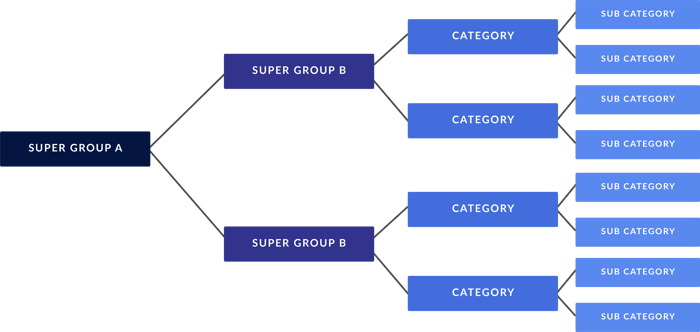
This leads to the better placement of products and better consumer understanding from a retailer and supplier level. Your hierarchy is informed by the consumer decision tree.
2. CATEGORY ROLE
You can classify a category role as the following:
- It positions the category within the portfolio of all of your product groupings within your store;
- It helps prioritise the category;
- It defines how you will use the category to achieve your overall business objectives; and
- It helps drive tactical decisions on price, promotion, product assortment and store location.
CONSUMER-BASED CATEGORY ROLES
There are four primary consumer-based category roles that you should know. They are:
1. DESTINATION ROLE
This is a category with which the retailer wants to profile themselves towards their target consumers and differentiate themself from their competition. It aims to offer superior value to consumers and define the retailer as a store of choice.
2. ROUTINE ROLE
This category aims to provide consistent and competitive value for the everyday needs of your customers. This category assists in developing the target consumer’s image of the retailer.
3. SEASONAL ROLE
This category refers to products that are not purchased regularly but occasionally. A seasonal category plays a secondary role in delivering profit but can be used by a retailer to differentiate itself from competition during certain periods.
4. CONVENIENCE ROLE
This is a category with which the retailer wants to profile himself towards his target consumers and differentiate himself from the competition. It aims to offer superior value to consumers and define the retailer as a store of choice.
3. INSIGHT GENERATION

Insight generation primarily involves competitor research, sales data, and in-depth analyses so that you can make better decisions regarding the layout of a shelf.
When doing so, there are three areas a retailer must look at that will help him to optimise his categories:
The use of this data and advanced analytics will benefit retailers in almost all areas of the business. It will help identify gaps between the current and desired state of the category and drive the strategic and tactical planning decisions.
For instance, loyalty analysis, which measures purchase frequency or penetration among high-priority consumer segments, allows you to understand product categories from a consumer perspective. By measuring consumer behaviour and understand why they switch brands, you can also identify which SKUs play a role and which are redundant.
Meanwhile, in using market basket analysis, you can identify key value items (KVIs) by consumer segment. You can thus set prices based on consumer demand and competitor moves. You can also tailor offers and promotions to consumers based on their past behaviours, thereby increasing total basket profitability and loyalty.
4. STRATEGIC AND TACTICAL PLANNING
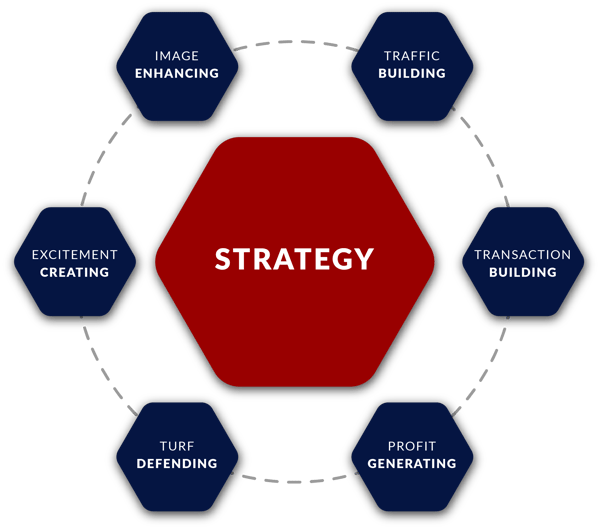
CATEGORY STRATEGIES
This is the step where you can develop strategies to deliver on the category role. The category role determines the depth of an assortment while your strategy determines the assortments focus.
Strategies enhance a category's strengths, focus on combating category threats and create opportunities for the segments.
The development of category strategies has six basic drivers:
- Traffic Building;
- Transaction Building;
- Profit Generating;
- Turf Defending;
- Excitement Creating; and
- Image Enhancing.
CATEGORY TACTICS
The goal of category tactics is to choose the best action to achieve a specific strategy based on the category role. In determining the appropriate tactic, you must review the four primary category roles (Destination, Routine, Seasonal, and Convenience).
These roles determine how the retailer makes decisions about the implementation of each tactic.
The tactics used are the 4 Ps:
- Product Assortment;
- Pricing;
- Promotion; and
- Merchandising Placement.
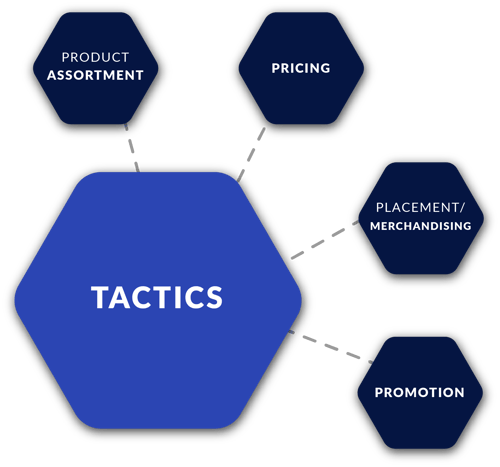
5. INITIATIVE DEVELOPMENT AND PLAN LAUNCH
During initiative development, you need to assess the cost versus the benefit before prioritising the next steps for implementation.
Your use this step to implement your category business plan through a schedule and list of responsibilities. Implementing a category plan as per the objectives laid down is the path to the success of a merchandising strategy.
A typical category plan in the implementation stage includes:
- What specific tasks you need to complete;
- When to do these task;
- Where to do the tasks; and
- Who will do the tasks?
It is vital that you secure commitment to resources for implementation. If you do not, you will have wasted all of the hard work you put into the first few steps because you do not have the right actions in place.
The planned launch requires you to create a timeline for rolling out your category management plan.
6. PLAN REVIEW
A category review is not necessarily listed as a step within the category management process as it needs to be completed on an ongoing basis.
This step is rather an ongoing measurement of the progress of your category plan and is a key indicator of the category's success. It allows you to determine whether or not you should make changes to the category plan.
There are five keys steps within the review process, namely:
- Monitor;
- Measure;
- Make changes;
- Maintain; and
- Move forward.
WHAT CATEGORY MANAGEMENT ACTIONS MUST YOU CONSIDER?
1. ASSORTMENT PLANNING
Having a solid assortment planning strategy is a big part of category management and allows you to focus on making the right products available in the right stores and at the right time
For the selection process, assortment planning software will use a set of rules to apply.
- Sales of a Product;
- Units Sold;
- Time on Shelf;
- External Sales Rank;
- House Brand;
- Top Brands;
- Colour or Flavour;
- Profitability.
This selection process will help you select the best-performing products in your store as well as in the market. It will also help you develop category management strategies that ensure you reach your target market/shoppers.
2. FLOOR SPACE PLANNING
A floor plan consists of a collection of planograms set out in a logical order for a store or various stores to maximise the utility of the available floor space.
Floor planners use specialised floor planning software to create heat-mapped floor plans. This helps you to optimise shopper traffic and to reduce congestion during peak hours.
Having products displayed in the same location in all chains creates brand consistency, which is beneficial to you if you have more than one store in a region.
Customers are more likely to return to your stores when they know where to find the product they are looking for, regardless of which branch they are visiting.
3. SPACE ALLOCATION AND MANAGEMENT
By taking into account the number of days it takes for a particular product to sell out, you can balance the space on the shelf to the sales of each product. This will help you to maximise your sales per square metre.
If the product takes longer to run out, give it less space and allocate that space to a product that sells out faster. In this way, you can increase your sales and profits.
4. VISUAL MERCHANDISING (OPTIMISING DISPLAY EFFICIENCY)
A planogram is a diagram, drawing or visual representation that indicates how and where to place products on shelves. Generating planograms that display products on the shelf in a visually appealing, logical and convenient way will help to attract and retain more shoppers.
Space planners use planograms to create logical product flows so that shoppers can easily navigate around the store and find what they need.
Planograms make any shelf replenishment task easier for store personnel as they can refer to the planogram to understand how to merchandise products. A planogram is also a valuable tool for retail executives as it allows them to have more control over their merchandising strategy and understand how the shelves in their stores are packed.
mistak
5. PRICE PLANNING
By using specialised business intelligence tools, you can decide on the best possible pricing.
By analysing data to calculate measures like price elasticity of demand, you can price your products for customer satisfaction and profit.
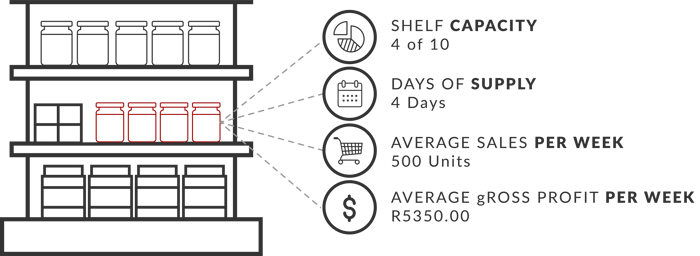
6. INVENTORY MANAGEMENT (TO AVOID OUT OF STOCK)
You can use planograms to determine space allocation and measure how fast a product moves off a shelf. This helps you determine the amount of SKUs you must order to ensure consistent days of supply for the products on a shelf.
An effective planogram will make the shelf replenishment cycle much easier and lead to decreased stock holding, reduced out of stocks, optimised stock rotation and increased inventory control.
For example, by using a product minimum display quantity, you can control running out of stock and the timing to place new orders.
7. PROMOTION PLANNING
Shoppers see these promotions on gondola ends, shelf hotspots and other convenient areas.
LET DOTACTIV HELP YOU BRING YOUR CATEGORY PLANS TO LIFE
Increase your revenue by between 5% and 30% by giving your products data-driven space allocations and applying consistent merchandising principles across your stores.
With our category management services, you’ll get quick access to the expertise, software and process required to ensure you choose ideal category roles with matching category tactics reflected in your planograms.
